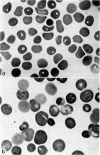Abstract
When Brucella abortus strain 19 is given intraperitoneally to mice it protects them against subsequent infection with large doses of Babesia microti. The protection obtained was more effective when B. abortus was given intraperitoneally than when it was injected subcutaneously. This non-specific protection seems to be best explained by the stimulation of macrophages so as to release a mediator which limits the intracellular replication of the parasites.
Full text
PDF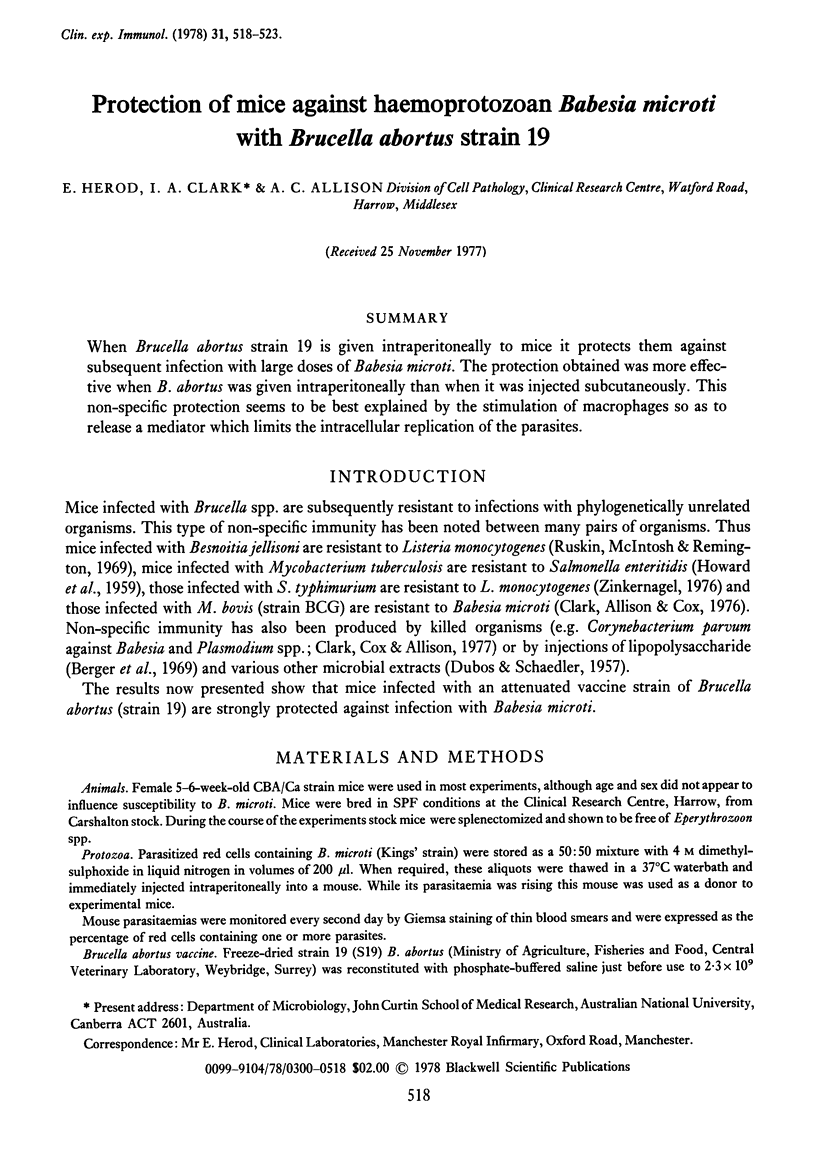
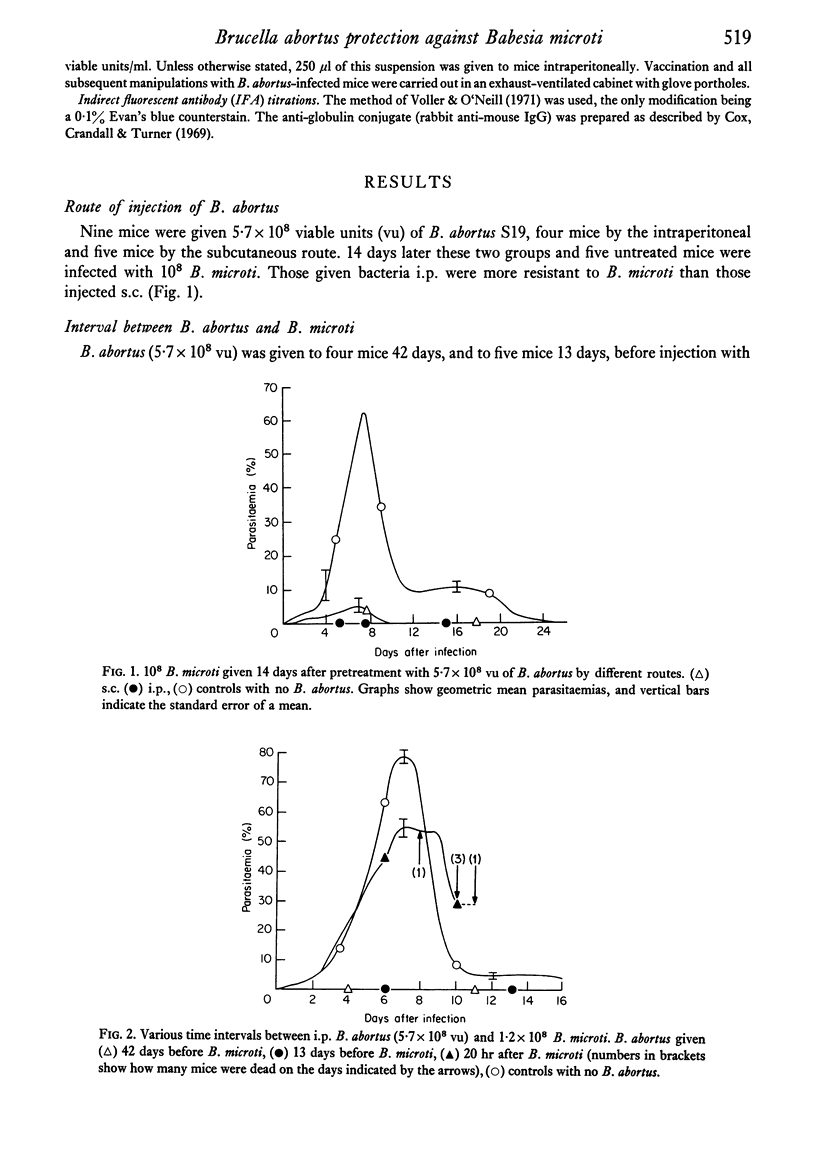
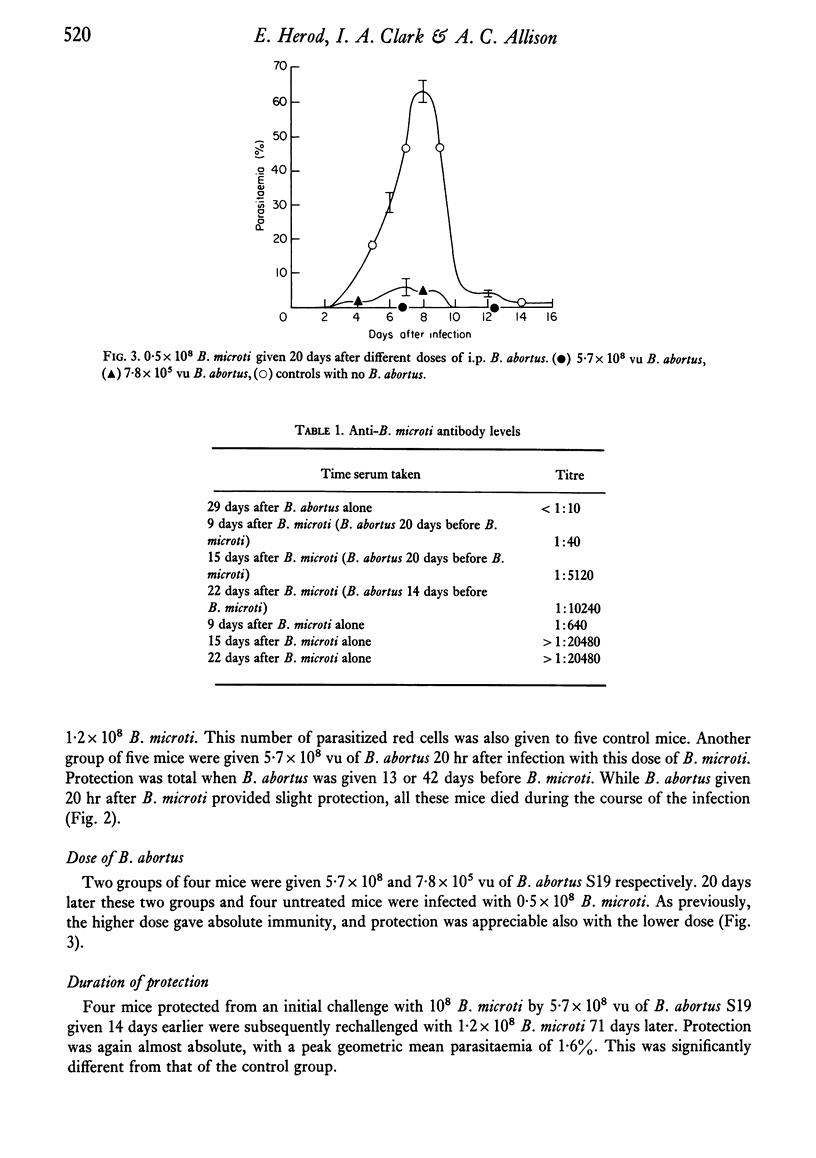
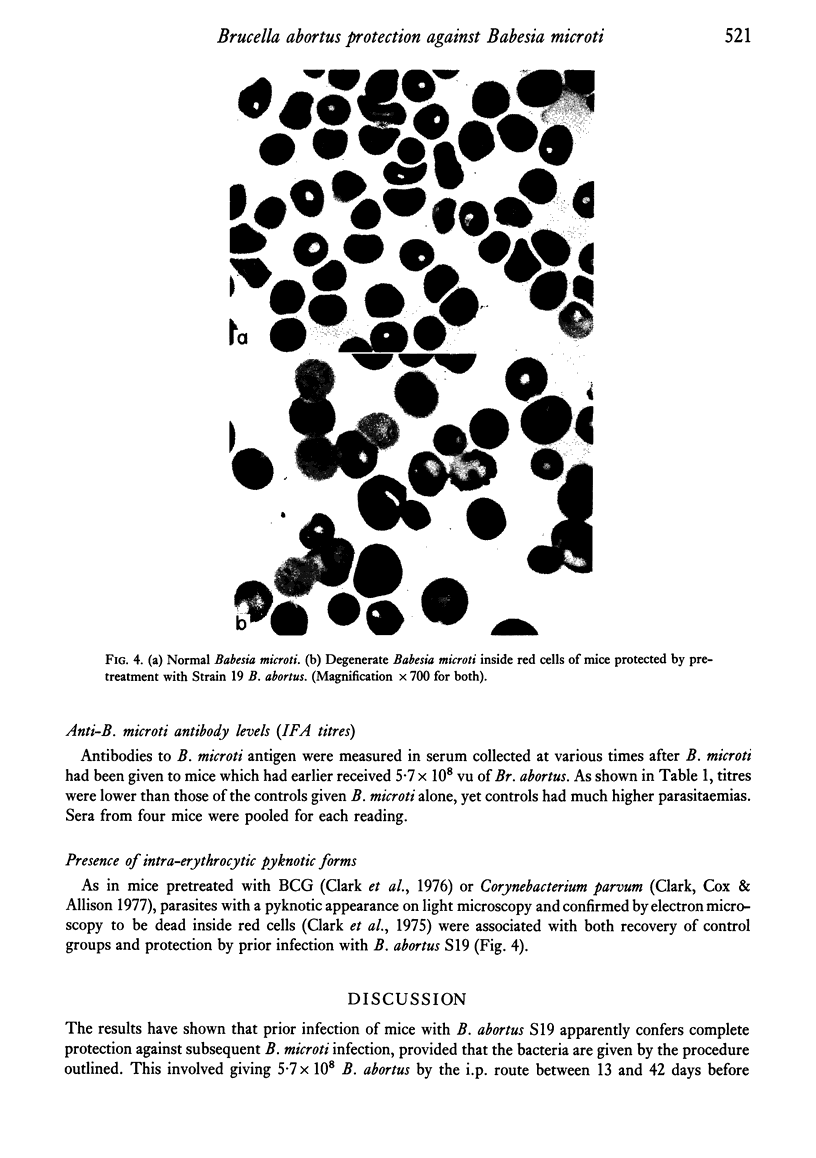
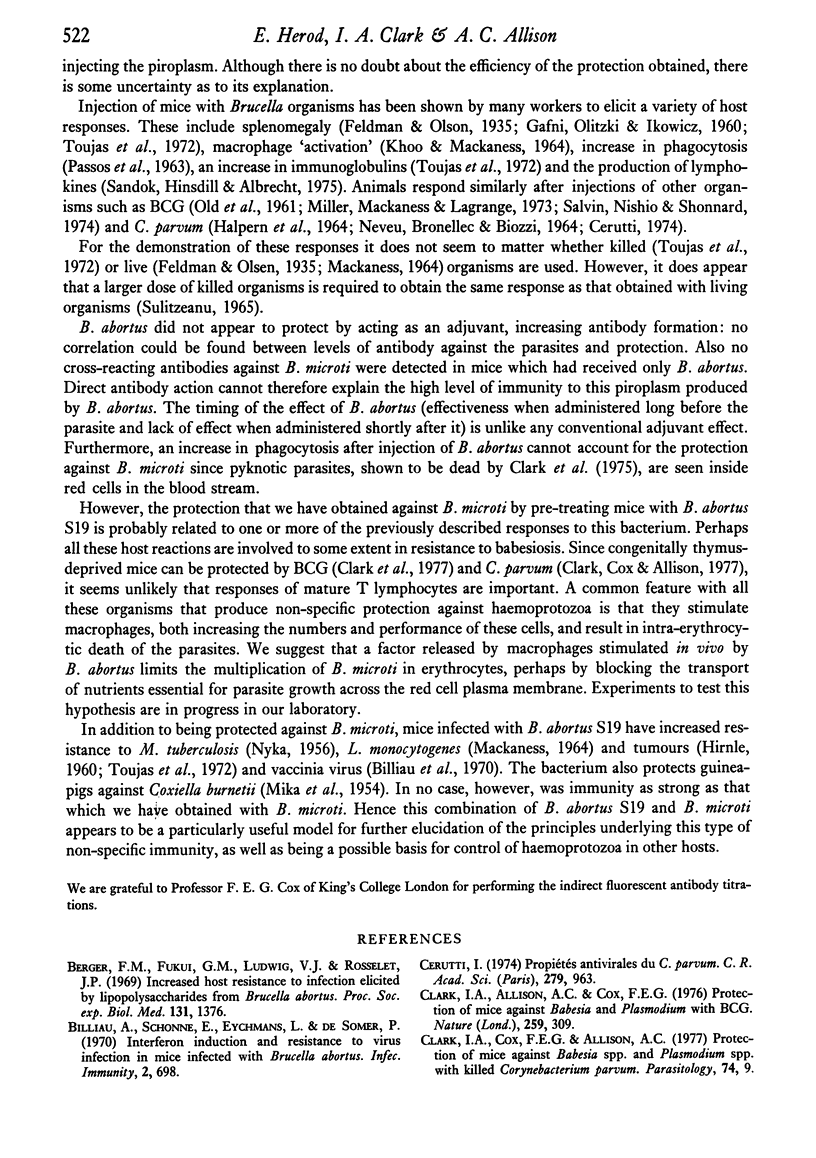
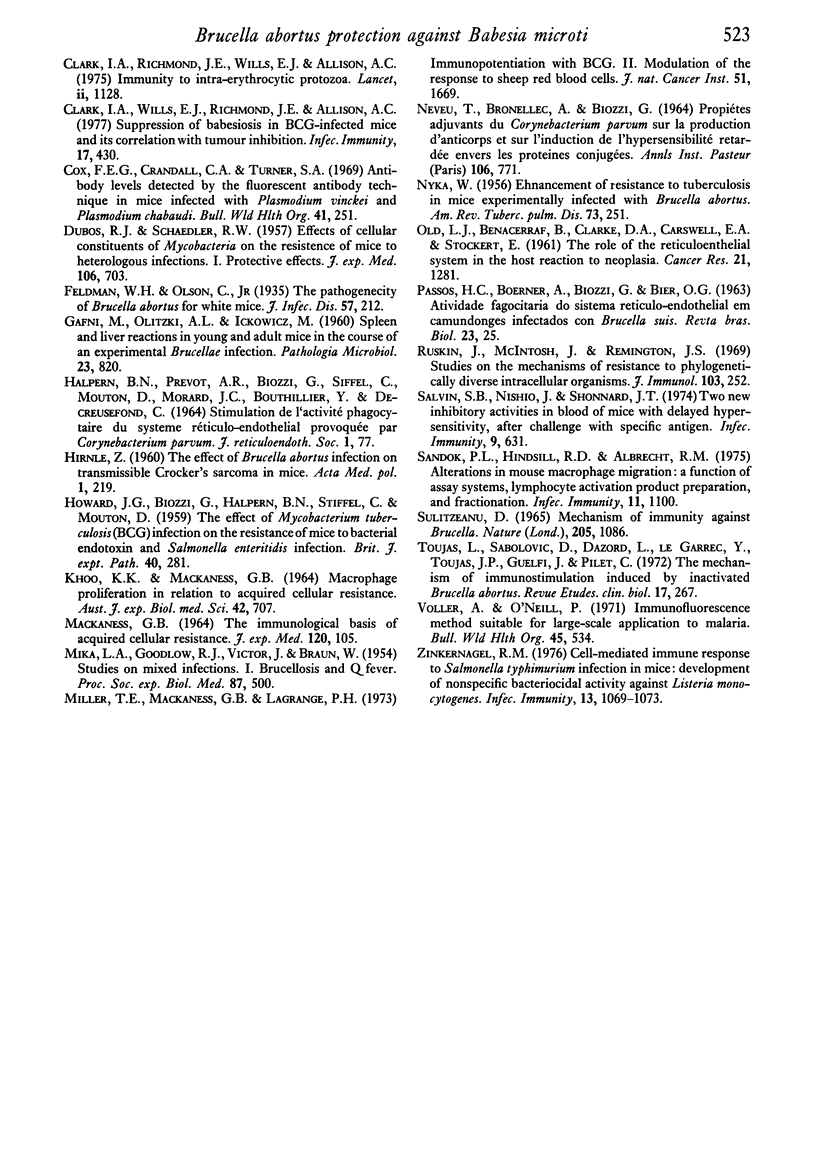
Images in this article
Selected References
These references are in PubMed. This may not be the complete list of references from this article.
- Berger F. M., Fukui G. M., Ludwig B. J., Rosselet J. P. Increased host resistance to infection elicited by lipopolysaccharides from Brucella abortus. Proc Soc Exp Biol Med. 1969 Sep;131(4):1376–1381. doi: 10.3181/00379727-131-34111. [DOI] [PubMed] [Google Scholar]
- Billiau A., Schonne E., Eyckmans L., De Somer P. Interferon Induction and Resistance to Virus Infection in Mice Infected with Brucella abortus. Infect Immun. 1970 Dec;2(6):698–704. doi: 10.1128/iai.2.6.698-704.1970. [DOI] [PMC free article] [PubMed] [Google Scholar]
- Cerutti I. Propriétés antivirales du C. parvum. C R Acad Sci Hebd Seances Acad Sci D. 1974 Sep 9;279(11):963–966. [PubMed] [Google Scholar]
- Clark I. A., Allison A. C., Cox F. E. Protection of mice against Babesia and Plasmodium with BCG. Nature. 1976 Jan 29;259(5541):309–311. doi: 10.1038/259309a0. [DOI] [PubMed] [Google Scholar]
- Clark I. A., Cox F. E., Allison A. C. Protection of mice against Babesia spp. and Plasmodium spp. with killed Corynebacterium parvum. Parasitology. 1977 Feb;74(1):9–18. doi: 10.1017/s003118200004748x. [DOI] [PubMed] [Google Scholar]
- Clark I. A., Richmond J. E., Wills E. J., Allison A. C. Immunity to intra-erythrocytic protoza. Lancet. 1975 Dec 6;2(7945):1128–1129. doi: 10.1016/s0140-6736(75)91010-7. [DOI] [PubMed] [Google Scholar]
- Clark I. A., Wills E. J., Richmond J. E., Allison A. C. Suppression of babesiosis in BCG-infected mice and its correlation with tumor inhibition. Infect Immun. 1977 Aug;17(2):430–438. doi: 10.1128/iai.17.2.430-438.1977. [DOI] [PMC free article] [PubMed] [Google Scholar]
- Cox F. E., Crandall C. A., Turner S. A. Antibody levels detected by the fluorescent antibody technique in mice infected with Plasmodium vinckei and P. chabaudi. Bull World Health Organ. 1969;41(2):251–260. [PMC free article] [PubMed] [Google Scholar]
- DUBOS R. J., SCHAEDLER R. W. Effects of cellular constituents of mycobacteria on the resistance of mice to heterologous infections I. Protective effects. J Exp Med. 1957 Nov 1;106(5):703–717. doi: 10.1084/jem.106.5.703. [DOI] [PMC free article] [PubMed] [Google Scholar]
- GAFNI M., OLITZKI A. L., ICKOWICZ M. Spleen and liver reactions in young and adult mice in the course of an experimental Brucellae infection. Pathol Microbiol (Basel) 1960;23:820–828. doi: 10.1159/000161044. [DOI] [PubMed] [Google Scholar]
- HIRNLE Z. The effect of Brucella abortus infection on transmissible Crocker's sarcoma in mice. Acta Med Pol. 1960;1(3-4):219–241. [PubMed] [Google Scholar]
- HOWARD J. G., BIOZZI G., HALPERN B. N., STIFFEL C., MOUTON D. The effect of Mycobacterium tuberculosis (BCG) infection on the resistance of mice to bacterial endotoxin and Salmonella enteritidis infection. Br J Exp Pathol. 1959 Jun;40(3):281–290. [PMC free article] [PubMed] [Google Scholar]
- KHOO K. K., MACKANESS G. B. MACROPHAGE PROLIFERATION IN RELATION TO ACQUIRED CELLULAR RESISTANCE. Aust J Exp Biol Med Sci. 1964 Dec;42:707–716. doi: 10.1038/icb.1964.67. [DOI] [PubMed] [Google Scholar]
- MACKANESS G. B. THE IMMUNOLOGICAL BASIS OF ACQUIRED CELLULAR RESISTANCE. J Exp Med. 1964 Jul 1;120:105–120. doi: 10.1084/jem.120.1.105. [DOI] [PMC free article] [PubMed] [Google Scholar]
- MIKA L. A., GOODLOW R. J., VICTOR J., BRAUN W. Studies on mixed infections. I. Brucellosis and Q fever. Proc Soc Exp Biol Med. 1954 Dec;87(3):500–507. doi: 10.3181/00379727-87-21424. [DOI] [PubMed] [Google Scholar]
- Miller T. E., Mackaness G. B., Lagrange P. H. Immunopotentiation with BCG. II. Modulation of the response to sheep red blood cells. J Natl Cancer Inst. 1973 Nov;51(5):1669–1676. doi: 10.1093/jnci/51.5.1669. [DOI] [PubMed] [Google Scholar]
- NEVEU T., BRANELLEC A., BIOZZI G. PROPRI'ET'ES ADJUVANTES DE CORYNEBACTERIUM PARVUM SUR LA PRODUCTION D'ANTICORPS ET SUR L'INDUCTION DE L'HYPERSENSIBILIT'E RETARD'EE ENVERS LES PROT'EINES CONJUGU'EES. Ann Inst Pasteur (Paris) 1964 May;106:771–777. [PubMed] [Google Scholar]
- NYKA W. Enhancement of resistance to tuberculosis in mice experimentally infected with brucella abortus. Am Rev Tuberc. 1956 Feb;73(2):251–265. doi: 10.1164/artpd.1956.73.2.251. [DOI] [PubMed] [Google Scholar]
- OLD L. J., BENACERRAF B., CLARKE D. A., CARSWELL E. A., STOCKERT E. The role of the reticuloendothelial system in the host reaction to neoplasia. Cancer Res. 1961 Oct;21:1281–1300. [PubMed] [Google Scholar]
- PASSOS H. C., BOERNER A., BIOZZI G., BIER O. G. ATIVIDADE FAGOCIT'ARIA DO SISTEMA RET'ICULOENDOTELIAL EM CAMUNDONGOS INFECTADOS COM "BRUCELLA SUIS". Rev Bras Biol. 1963 Jun;23:25–30. [PubMed] [Google Scholar]
- Ruskin J., McIntosh J., Remington J. S. Studies on the mechanisms of resistance to phylogenetically diverse intracellular organisms. J Immunol. 1969 Aug;103(2):252–259. [PubMed] [Google Scholar]
- Salvin S. B., Nishio J., Shonnard J. T. Two new inhibitory activities in blood of mice with delayed hypersensitivity, after challenge with specific antigen. Infect Immun. 1974 Apr;9(4):631–635. doi: 10.1128/iai.9.4.631-635.1974. [DOI] [PMC free article] [PubMed] [Google Scholar]
- Sandok P. L., Hinsdill R. D., Albrecht R. M. Alterations in mouse macrophage migration: a function of assay systems, lymphocyte activation product preparation, and fractionation. Infect Immun. 1975 May;11(5):1100–1109. doi: 10.1128/iai.11.5.1100-1109.1975. [DOI] [PMC free article] [PubMed] [Google Scholar]
- Sulitzeanu D. Mechanism of immunity against brucella. Nature. 1965 Mar 13;205(976):1086–1088. doi: 10.1038/2051086a0. [DOI] [PubMed] [Google Scholar]
- Toujas L., Sabolovic D., Dazord L., Le Garrec Y., Toujas J. P., Guelfi J., Pilet C. The mechanism of immunostimulation induced by inactivated Brucella abortus. Rev Eur Etud Clin Biol. 1972 Mar;17(3):267–273. [PubMed] [Google Scholar]
- Zinkernagel R. M. Cell-mediated immune response to Salmonella typhimurium infection in mice: development of nonspecific bactericidal activity against Listeria monocytogenes. Infect Immun. 1976 Apr;13(4):1069–1073. doi: 10.1128/iai.13.4.1069-1073.1976. [DOI] [PMC free article] [PubMed] [Google Scholar]



